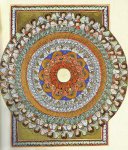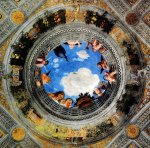Issue
-
Returning to Eden
Revaluation of the Earthly World. From Antiquity to the Ancien Régime
Organized by José María SALVADOR-GONZÁLEZ (org.)
Mirabilia Journal 38 (2024/1)

-
The Kingdom of the Spirit
The Transcendent, from the Ancient World to the Ancien Régime
Organized by Humberto Schubert COELHO (org.)
Mirabilia Journal 39 (2024/2)

-
Intercultural Mediterranean
From Antiquity to Baroque
Organized by Antonio CORTIJO OCAÑA; Vicent MARTINES (orgs.)
Mirabilia Journal 40 (2025/1)

-
Languages and Cultures in Tradition
Art, Philosophy and Literature
Organized by Ricardo da COSTA (org.)
Mirabilia Journal 41 (2025/2)

Article
-
Presentation
Alexander Fidora and Jordi Pardo Pastor
Published in Expressing the Divine: Language, Art and Mysticism
-
Memory and Rhapsody: The Divine Song in Archadia
Ciléa Dourado
Original title: Memória e Rapsódia: o canto divino na Arcádia
Published in Expressing the Divine: Language, Art and Mysticism
The poetic activity of the Greek Golden Age, better known as Archadia, grew inside a pre-literate culture which was characterized, above all, by a mythological symbolism. The Archadian poetry points to the notion of the fantastic, of the sublime and of the divine in its purest form. The archaic Poet was endowed with the power directly by the gods, and such a power was non-negotiable and non-transferable. The lineage and succession of a rhapsodist was often brought out by Arete, the choice of the nobler.
-
The Relationship between Divinity and Secular Power on Laconian Black-Figure Vases in the 6th Century B.C.
José Francisco de Moura
Original title: Vínculos entre divindade e poder secular nos vasos de figuras negras da Lacônia no século VI a.C.
Published in Expressing the Divine: Language, Art and Mysticism
This article wants to examine the divine images on Laconian black-figure vases with regard to the iconography in other types of Laconian materials, thus hoping to understand their politico-social function in the context of the Spartan society of the 6th century b.C.
-
The Quotidianity of an Image: the Face of the Christ
Ofelia Manzi
Original title: La Cotidianeidad de una imagen: el rostro de Cristo
Published in Expressing the Divine: Language, Art and Mysticism
After the third century, a widespread repertoire of Christian images is created. Recognition of the characters of Biblical history was made by their assimilation to motifs of Roman art. The study of origin, development and modifications that modified the face of Christ offers the possibility of analyzing the multiple sources for this image as well as establishing the changes of its meaning, that run parallel to the history of the Church.
-
Superstition and Religiousness in the Res publica: Areas of Power?
Luís Filipe Silvério Lima
Original title: Superstições e Religiosidade na Res Publica: Espaços de Poder?
Published in Expressing the Divine: Language, Art and Mysticism
This paper deals with the links between religion and prophecy as forms of power in Livy.


















































































